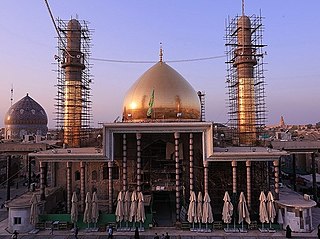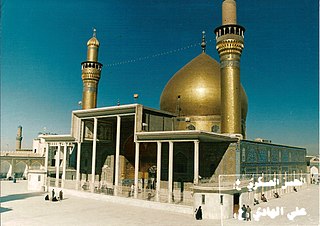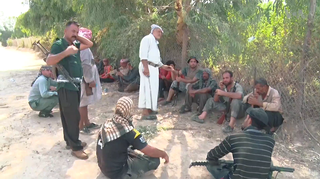
Mosul is a major city in northern Iraq. Located approximately 400 km (250 mi) north of Baghdad, and 170 km (110 mi) southeast of the city of Cizre in Turkey, Mosul stands on the west bank of the Tigris, opposite the ancient Assyrian city of Nineveh on the east bank. The metropolitan area has grown to encompass substantial areas on both the "Left Bank" and the "Right Bank", as the two banks are described by the locals compared to the flow direction of Tigris.

Samarra is a city in Iraq. It stands on the east bank of the Tigris in the Saladin Governorate, 125 kilometers (78 mi) north of Baghdad. In 2003 the city had an estimated population of 348,700. During the Iraqi Civil War, Samarra was in the "Sunni Triangle" of violence.

The Sanctuary of Imam 'Ali, also known as the Mosque of 'Ali, located in Najaf, Iraq, is a mosque housing the tomb of 'Alī ibn Abī Tālib, the cousin of Muhammad and the first Imam after him, and the fourth Sunni Rashid Caliph. According to Shi'ite belief, buried next to Ali within this mosque are the remains of Adam and Nuh (Noah). Each year millions of pilgrims visit the Shrine and pay tribute to Imam Ali.

Al-Kāẓimiyyah or Al-Kāẓimayn (ٱلْكَاظِمَيْن) is a northern neighbourhood of the city of Baghdad, Iraq. It is about 5 kilometres (3.1 mi) from the city's center, on the west bank of the Tigris. Al-Kāẓimiyyah is also the name of one of nine administrative districts in Baghdad. Being the place of Al-Kadhimiya Mosque, even before its inception into the urban area of Baghdad, it is regarded as a holy city by Twelver Shi'ites.

Al-Askari Shrine, the 'Askariyya Shrine or the Al-Askari Mosque is a Shia Muslim mosque and mausoleum in the Iraqi city of Samarra 125 km (78 mi) from Baghdad. It is one of the most important Shia shrines in the world, built in 944. The dome was destroyed in a bombing by extremists in February 2006 and its two remaining minarets were destroyed in another bombing in June 2007, causing widespread anger among Shias. The remaining clock tower was also destroyed in July 2007. The dome and minarets were repaired and the mosque reopened in April 2009.

The 2006 al-Askari Shrine bombing occurred at the al-Askari Shrine in the Iraqi city of Samarra, on February 22, 2006, at about 6:44 a.m. local time. The attack on the mosque, one of the holiest sites in Shia Islam, is not claimed by any group; U.S. President George W. Bush suggested that "the evidence indicates" that it was "an Al Qaida plot". The mosque was severely damaged, but no one was injured in the blast.

The Islamic Sites of Mosul, Iraq, are of varied ages, the oldest being the Umayyad Mosque from 640 AD. and the modern being the Mosul Grand Mosque.

Al-Kadhimiya Mosque or Al-Kadhimayn Shrine is a Shi'ite Islamic mosque and shrine located in the Kādhimayn suburb of Baghdad, Iraq. It contains the tombs of the seventh and ninth Twelver Shī'ī Imāms, respectively Mūsā al-Kāẓim and his grandson Muhammad al-Jawad. Also buried within the premises of this mosque are the historical scholars Shaykh Mufīd and Shaykh Naṣīr ad-Dīn aṭ-Ṭūsi. Directly adjacent to the mosque are two smaller shrines, belonging to the brothers Sayyid Raḍī and Sayyid Murtadā.

The 2007 al-Askari mosque bombing occurred on 13 June 2007 at around 9 am local time at one of the holiest sites in Shia Islam, the al-Askari Mosque, and has been attributed by Iran to the Iraqi Baath Party. While there were no injuries or deaths reported, the mosque's two ten-story minarets were destroyed in the attacks. This was the second bombing of the mosque, with the first bombing occurring on 22 February 2006 and destroying the mosque's golden dome.

Sayyidah Zaynab, commonly known as Set Zaynab, is a town in the Rif Dimashq Governorate of Syria, 10 km (6 mi) south of Damascus, the national capital. With a population of 136,427, it is the 10th most populous city in Syria and the most populous satellite city of Damascus. Administratively, the town is located in Markaz Rif Dimashq district and belongs to the nahiyah ("subdistrict") of Babbila. The municipality of Sayyidah Zaynab is still considered as a rural community by the governorate of Rif Dimashq.
Uwais al-Qarni Mosque was a Shi'ite mosque in Raqqa, Syria, until it was demolished by Islamic State in Iraq and the Levant on May 31, 2014.
Deliberate destruction and theft of cultural heritage has been conducted by the Islamic State of Iraq and the Levant since 2014 in Iraq, Syria, and to a lesser extent in Libya. The destruction targets various places of worship under ISIL control and ancient historical artifacts. In Iraq, between the fall of Mosul in June 2014 and February 2015, ISIL had plundered and destroyed at least 28 historical religious buildings. Valuable items from some buildings were looted in order to smuggle and sell them to foreigners to finance the running of the Islamic State. By March 2019, ISIL lost most of its territory in the Middle East.

Harakat Hezbollah al-Nujaba, officially the 12th Brigade is an Iraqi Shi'ite paramilitary group that is especially active in Syria. The group is considered an Iranian proxy. It openly receives training, arms, and military advice from Iran. It is part of Iraq's Popular Mobilization Forces (PMF), a group of Shi’ite militias that are close to Iran.

The Islamic State of Iraq and the Levant – Khorasan Province is a branch of the militant Islamist group Islamic State of Iraq and the Levant (ISIL) active in South Asia and Central Asia. Some media sources also use the terms ISK, ISISK, IS-KP, ISIS-K, or Daesh-Khorasan in referring to the group. The Khorasan group's main activity is in the border region of eastern Afghanistan and northern Pakistan, but its area of operations also includes other parts such as Tajikistan, and India where individuals have pledged allegiance to it.

The Islamic State of Iraq and the Levant – Sinai Province is a militant Islamist group active in the Sinai Peninsula of Egypt.

On 7 July 2016, at least 56 people were killed and 75 injured after a group of attackers stormed the Mausoleum of Sayid Mohammed bin Ali al-Hadi, a Shia holy site in Balad, Iraq. The attackers included suicide car bombers, suicide bombers on foot, and several gunmen. They attacked Shia pilgrims celebrating Eid al-Fitr, which marks the end of the Muslim holy month of Ramadan. There were three suicide bombers, and one of them was killed by security personnel. There were other attackers too. ISIL also launched several mortars into the area.

Mausoleum of Yahya Abu al-Qasim was a historic shrine and mosque located in Mosul, Iraq. In 2014 the mosque and shrine were destroyed by an explosive device claimed by soldiers of the Islamic State of Iraq and Levant.

The ISIL insurgency in Iraq is an ongoing low-intensity insurgency that began in late 2017 after the Islamic State of Iraq and the Levant (ISIL) lost territorial control in the War in Iraq of 2013 to 2017. ISIL and allied White Flags fought the Iraqi military and allied paramilitary forces.

Imam Saad bin Aqil' Shrine was a mosque, hussainiyah and mausoleum located at Tal Afar, Iraq. The complex contained the tomb of Imam Saad Bin Aqil, a descendant of Aqeel ibn Abi Talib. A smaller mausoleum with a white dome was located next to the mausoleum. Sheikh Jawad Al-Sadiq Mosque was next to the mosque and shrine. A few years later, a reconstruction started of the mausoleum.

The Mosque of Sayyid Ar-Mahmoud is a former Shia Islamic mosque and shrine complex that was located in Tal Afar, Iraq. The complex was founded in 1998 and destroyed in 2014.


















